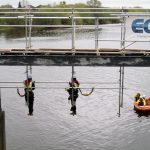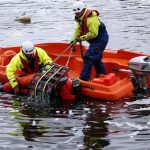River rescue procedures for maintenance project proven
ECS Engineering Services has been awarded a contract by the Environment Agency to repaint the metalwork of Colwick Sluice in Nottingham. In preparation for the work it has been necessary to construct complex scaffolding that will provide safe access to the water control structure. To demonstrate the importance of safety during this process, ECS commissioned a video to demonstrate the additional safety measures required for projects such as this.
Working above water always requires extra care, but when the walkways and barriers need to be removed in order to access the metalwork under maintenance, additional safety measures need to be installed. For this particular project the construction of the scaffold required a 3-man dive team and a rescue boat to be on the water at all times while the scaffolders were working.

The scaffold was created in stages, working from one end of the sluice to the other. The team members installing the scaffold used a double lanyard harness meaning that they were always attached to the scaffold, even when moving from one section to another.
Jamie Wesley, Contracts Manager at ECS, comments: “As part of the project planning, the risk assessment required an escape plan to be in place in the event of one of the scaffolders slipping and falling. Initially the harness would reduce the extent of the fall, but due to the nature of the scaffold construction, it may not be possible for the scaffolder to be recovered from this position.”
In such a situation, each scaffolder was equipped with a strap knife which could be used to cut the lanyards, allowing him to drop into the water below. At this point the alarm would be raised and the rescue boat would move to the location of the casualty and recover him into the boat.
In order to demonstrate the effectiveness of this rescue plan, ECS invited the Environment Agency to the site to witness the value of the safety drill. The scaffolders dropped a life-size dummy, provided by the dive rescue team, into the water before it was rescued by the dive team. Throughout the drill a film crew was on hand to document the procedure.
The demonstration proved the speed and efficiency of the rescue process, minimising the amount of time that the casualty would spend in the water. This was due in part to the use of a jason’s cradle, which significantly reduces the time taken to recover the casualty into the rescue boat.
Jamie concludes: “This exercise has proven to be very useful in ensuring that we have all the necessary assets in place for this project. Safety is of paramount importance in every aspect of our work and we make every effort to avoid and minimise risk wherever possible.”
- The construction of the scaffold required a 3-man dive team and a rescue boat to be on the water at all times while the scaffolders were working.
- The scaffolders dropped a life-size dummy, provided by the dive rescue team, into the water before it was rescued by the dive team.







